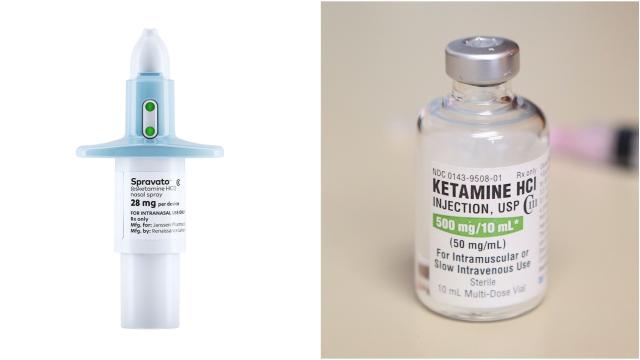You’ve probably heard a lot about ketamine this week, thanks to the US Food and Drug Administration’s decision to approve a nasal spray based on the drug as a new depression treatment. But given ketamine’s long-standing reputation as a recreational drug — so notorious that users talk about entering a “K-hole” after taking it — you might have some questions about what exactly makes the FDA-approved version different.
The short history lesson behind ketamine is that it was first discovered in the 1960s and quickly put to use as a safer anaesthetic alternative to phencyclidine, or PCP as it’s better known.
Both are considered dissociative anaesthetics. But while PCP can sedate you, it can also cause awful side-effects like psychosis. Ketamine, on the other hand, is still used as a general anaesthetic or painkiller in people and animals to this day.
But it wasn’t long after its discovery that people realised that ketamine’s dissociative effects, like those of PCP, could make it a potent party drug.
The out-of-body experience caused by ketamine can feel euphoric, but when it doesn’t — when it’s a paralysing, hallucinogenic, often frightening ordeal — that’s when recreational users talk about falling into a K-hole. This mostly happens when taking especially high doses.
The doses of ketamine people are getting to treat their depression, though, are much smaller, according to Dennis Charney, dean of the Icahn School of Medicine at Mount Sinai and one of the first scientists to study ketamine’s effects on depression.
“The dosage can depend from person to person in these clinics. And the same is true of someone taking it recreationally. But typically, we’re talking about doses that are smaller by several-fold in magnitude,” he told Gizmodo.
Aside from dosage, the active ingredient in the new nasal spray Spravato, developed by Johnson & Johnson, isn’t actually ketamine per se.
The ketamine people use as a sedative, club drug or antidepressant is, chemically speaking, something called a racemic mixture. A racemic mixture is made from the equal combination of two near-identical molecules. These molecules are chemically the same, but their structure looks like the mirror image of the other, much like your left and right hand.
So ketamine is the racemic mixture of R- and S-ketamine. Spravato is derived just from S-ketamine, more plainly known as esketamine.
According to Charney, one of the co-inventors of the nasal spray that was licensed to J&J and later developed as Spravato, there were practical reasons for going with esketamine over ketamine (Charney told Gizmodo that he himself played no role in the actual development of Spravato, though he will obviously profit from the drug’s approval).
Namely, some research has suggested that esketamine can provide similar antidepressive effects as ketamine but with a lower risk of side effects. That said, no one has seemingly compared the two versions directly, though at least one upcoming study plans to.
Neither version, despite being taken in a lower dose than people use recreationally, is free of side effects though. In trials, patients have reported disorientation, high blood pressure and vomiting; others taking ketamine for depression have also talked about feeling something like a euphoric trip.
These side-effects, and the worry that sustained esketamine use could lead to dependence, have led the FDA to strictly regulate how Spravato will be used. The drug is only approved for patients with depression who haven’t responded to other antidepressants.
Patients will also have to take the drug in approved clinics or medical offices under medical supervision on a tight schedule over a period of weeks, complete with a two-hour monitoring period afterwards before they can leave the clinic (in the trials of Spravato, the majority of side effects faded by the two-hour mark).
These limitations, experts hope, will make the medical use of esketamine a different and safer experience than recreational use of ketamine.
